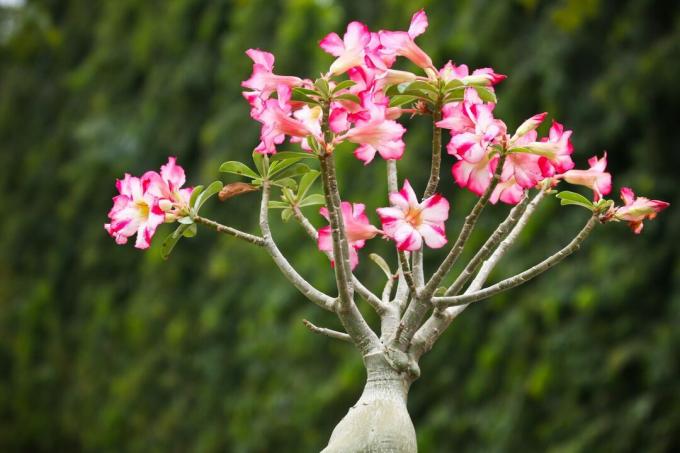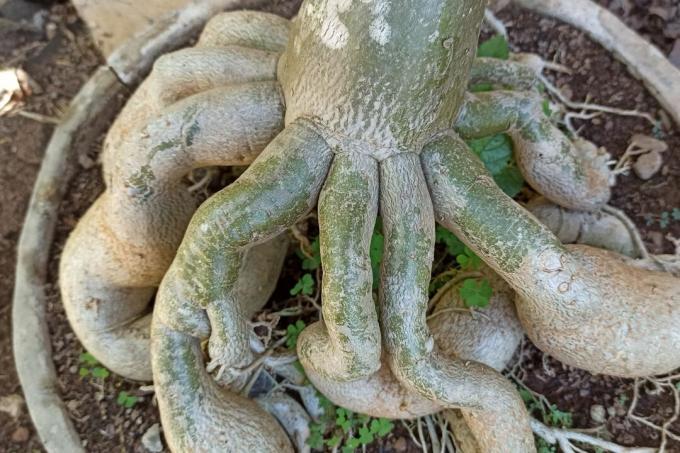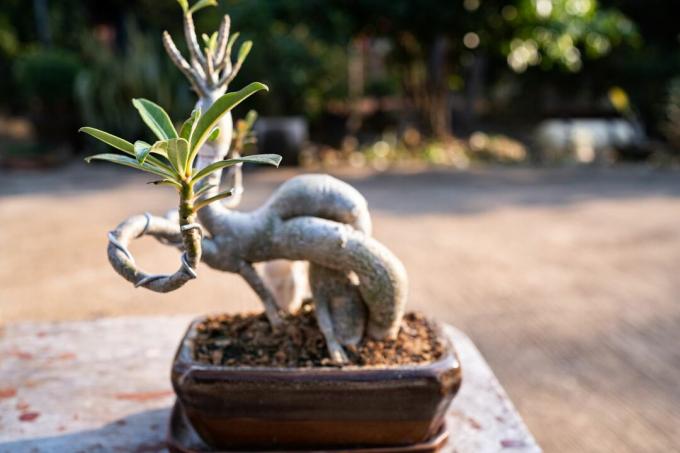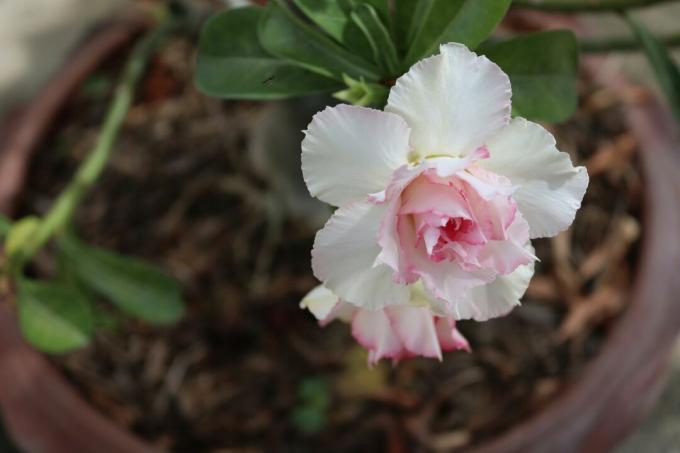The name of the desert rose (Adenium) does not necessarily suggest, but the drought-loving plantspoils you with numerous flowers.

Depending on the variety, the desert rose can bloom red, pink or white and also has the most unusual stem forms. We show how the undemanding succulents can be cared for and introduce the most beautiful varieties.
contents
- Desert rose: origin and characteristics
- The most beautiful desert rose varieties and species
- Cultivation, location and soil
-
Maintaining the desert rose
- Cut, water and fertilize desert rose
- Yellow leaves and leaf loss on the desert rose: what to do?
- Propagating desert rose: seeds, cuttings and Co.
- Hibernate desert rose
- Is the desert rose poisonous?
Desert rose: origin and characteristics
The desert rose is a genus of plants that can be found in parts of Africa as well as on the Arabian Peninsula. It belongs to the dog poison family (Apocynaceae) and contains the milky sap typical of this family of plants. It escapes when the plants are injured and can irritate the skin or even cause poisoning. The desert rose survives the dry season in its homeland without any problems. It is a stem succulent, which means it can store water in the so-called caudex. This is the term used to describe the storage organ of the plant between the root and the trunk. The caudex can be shaped and pronounced in different ways and can look very decorative.
The evergreen shrub therefore sometimes appears like a tree and can reach heights of up to five meters in nature. But how big does a desert rose get in indoor culture? That depends on the variety and can vary from 30 cm to 3 meters. The leaves are oval, thickened and dark green. Adenium not only impresses with its interesting trunk shapes and evergreen leaves, but also with its pretty flowers. The desert rose flowers show up from April and stay until July. The desert rose can bloom in all shades of color from white to purple. Even double flowers are available from breeding.

The most beautiful desert rose varieties and species
There is still disagreement about the types and varieties of desert roses. It is sometimes assumed that there is only one type of desert rose, namely the common desert rose (Adenium obesum). All other representatives would therefore be subspecies. However, it is also possible that there are several different types. Whether a separate species or subspecies, all of the following desert roses are suitable as indoor plants and are beautiful to look at.
- Adenium obesum: The common desert rose is considered the actual desert rose. Your flowers can have different colors, usually the flower inside is lighter in color than outside, which results in a nice color transition.

- Adenium arabicum: This Somali desert rose sees Adenium obesum very similar. If you want to cultivate the desert rose as a bonsai, it is best to do so Adenium arabicum as it is best suited for these purposes.

- Adenium multiflorum: As the name suggests, this desert rose scores above all with its impressive display of flowers. In nature, however, this species does not get that big and it usually stays at a height of about three meters.

- Desert rose ‘snow white’: This desert rose variety has white flowers and double flowers. So it appears particularly splendid.

- Desert rose ‘Golden Dragon’: The ‘Golden Dragon’ variety, which develops yellow flowers, is rather unusual for desert roses.

Cultivation, location and soil
Adenium is a very frugal houseplant that does not cause any problems when it comes to maintenance. To join a Adenium To be able to please, you do not need to buy a ready-made plant, you can also grow the desert rose from seeds. When using seeds, the caudex of the small plants is usually better developed than with offspring obtained from cuttings. In spring, distribute the seeds on the growing medium and cover the seeds with soil. The layer should be a maximum of one centimeter thick. Keep the soil moist and place the container in a warm and bright place at around 20 to 25 ° C. The first seedlings can appear after a week. When the first pairs of leaves appear, you can repot the small desert roses. When planting, the part of the caudex where most of the roots are located should be covered with soil. You can also leave a slightly larger part of the caudex on the surface and simply cut off the upper fine roots. A shallow pot ensures that the caudex is not long and pole-shaped.

The desert rose needs a location that is warm and very sunny. It can therefore be placed directly at the south window without any problems, as long as there is no constant draft there. Temperatures of around 20 ° C are recommended, but it can also be warmer. Dry air is also not a problem. As soon as the temperatures are in the double digits in summer, you can also put the desert rose outside. There, the enjoyment of light is usually higher than at the window and Adenium receives the best conditions for vigorous, albeit slow growth.
So that the conditions are right in the root area, the substrate must be permeable and the pot must have a drainage hole. As with most plants, a drainage layer made of coarse material such as pebbles on the bottom of the pot is recommended. Then plant the desert rose in a mixture of two thirds of the potting soil and at least one third of quartz sand, which increases the permeability. You can use our Plantura organic universal soil whose pH value is in the optimal range for the desert rose and is mainly made from recycled vegetable raw materials.
Maintaining the desert rose
If you are looking for an undemanding houseplant, you have come to the right place with the desert rose. Dryness and warmth are the two basic requirements for successful desert rose care.
Cut, water and fertilize desert rose
The most important thing when watering the desert rose is to avoid waterlogging. Remove any water that drains into the coaster after you pour it. It is only poured when the substrate is dry to the touch. In any case, the desert rose tolerates drought better than wetness. In winter, the water supply can be almost completely stopped. When it gets too cold and there is little watering, the desert rose goes into a resting phase and sheds its leaves. It will then sprout again in the next spring.

The desert rose is only fertilized in the growth phase. No fertilizer is needed in the winter dormancy. The growing season extends from March to October, during which time you can fertilize about every four weeks. If available, use a cactus fertilizer or use a green plant fertilizer in half the dosage. Our is an example of this Plantura organic indoor & green plant fertilizer which is suitable for almost all indoor plants. In addition to the important nutritional elements nitrogen and potassium, it also contains microorganisms that support root growth.
It is not necessary to cut the desert rose as it grows very slowly anyway. However, if you want to intervene in the shape, a cut is possible because the desert rose will sprout again at this point. The best time is after the flowering period. Otherwise the created flower buds could also be cut off.
You can also repot the desert rose at this time. However, this is sufficient every few years if the roots grow out of the bottom of the pot, as growth proceeds very slowly.

Yellow leaves and leaf loss on the desert rose: what to do?
Is your desert rose losing leaves or is it turning yellow? There is nothing to worry about.
- Yellow leaves: If you intentionally send the desert rose to hibernation in winter by stopping the watering, the leaves will turn yellow and fall off. At other times, however, too much or too little of nutrients or root rot due to waterlogging can be the trigger for the leaf change.
- No flowers: The desert rose does not bloom? For a rich flowering in spring, the resting phase in winter is crucial. If there is no proper overwintering, there may be failures in the flower and also in the leaves.
- Leaf loss: It is quite normal for the desert rose as a houseplant to lose its leaves in winter if it is no longer watered. It also gets too little light in the cold season. However, if the leaves fall off in spring or summer, there may be a care error.
- Pests: The desert rose is seldom afflicted by diseases or pests. Spider mites or Mealybug especially like the dry air in winter. In the event of an infestation, the plant should be carefully but thoroughly washed off.

Propagating desert rose: seeds, cuttings and Co.
Both cuttings and seeds are suitable for propagating the desert rose. The decisive advantage with seeds is the more pronounced caudex.
The desert rose is propagated via cuttings in summer or spring. Shoots without flowers, but with at least two pairs of leaves, are used. Cut off a shoot with a sharp cutting tool and let it dry for a day or two. Then you can stick the cutting in potting soil and keep it warm and slightly moist.
The use of your own seeds is also promising. The seeds ripen between July and August and are located in elongated, brown capsules. The ripe capsules are harvested and the seeds removed. Then you can start sowing straight away, because the germination capacity is highest with fresh seeds. You can find out how to do this in the paragraph on cultivation, soil and location above.

Hibernate desert rose
Hibernating the desert rose is crucial for flower formation over the next year. In the cold season of the year, the sun-loving succulent plant does not get enough light for growth anyway and is therefore put into a resting phase.
It is important that the temperature does not drop below 15 ° C even in winter. In the cold season there is no fertilization and only very reduced watering. During the winter dormancy - also called drought in the case of the desert rose - the leaves of the actually evergreen plants are thrown off. After a successful wintering, however, flowers and leaves sprout again abundantly from spring as soon as watering is started again. Every few years, if the pot has become too small, the desert rose can be repotted after the hibernation but before the new shoots.

Is the desert rose poisonous?
The desert rose is poisonous because of its milky sap. It should neither touch the skin nor be consumed as it can cause skin irritation and poisoning. Gloves can be worn when working to protect against the juice. The desert rose should not be placed within the reach of children or pets.
There are many more blooming succulentssome of which are even hardy. We have put together a small overview for you.



